Have you ever been weeding an endless, blinding, white shell driveway to find yourself carelessly throwing weeds into your bucket as if they have no value? Frequently, we find ourselves valuing some plants over others because of what we’ve learned as landscapers. Our view of plant life is formed by some old rule where one plant belongs and another doesn’t. As it turns out, nearly every plant has a value beyond its ornamental purpose. You just have to think outside of the landscaper’s mindset. How exciting!
To a landscaper, weeds pulled during summer maintenance are little more than busy work. However, in the eyes of an herbalist, these same plants are highly valued for their essential vitamins, nutrients, and exponential healing qualities! Humans have been using plants as medicine for thousands of years; though recently, we have lost touch with our intimate knowledge of, and connection to the plant world. While much knowledge has been lost over time, modern people are rediscovering the many medicinal properties and uses of plants, re-establishing our necessary relationship with the natural world.
Here are few medicinal gems you are likely to come across while weeding the gardens, driveways, lawns, and patios of our beloved island:
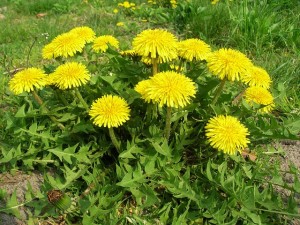 Dandelion, Taraxacum officinalis, is probably one of the most recognizable weeds and can be identified by its bright yellow flower and hairless, dark green leaves. The plant’s tap root can be processed into a tincture, tea, or oil infusion. As a tea or tincture, dandelion root works to cleanse the liver, aid digestion, and ease pre-menstrual symptoms and menstrual bloating. The flowers, when drank as a tea, help to hydrate skin. When applied topically, an oil infusion of the flowers can soothe sore muscles and facilitate stress release from the body. Dandelion leaves are edible and high in vitamins and minerals.
Dandelion, Taraxacum officinalis, is probably one of the most recognizable weeds and can be identified by its bright yellow flower and hairless, dark green leaves. The plant’s tap root can be processed into a tincture, tea, or oil infusion. As a tea or tincture, dandelion root works to cleanse the liver, aid digestion, and ease pre-menstrual symptoms and menstrual bloating. The flowers, when drank as a tea, help to hydrate skin. When applied topically, an oil infusion of the flowers can soothe sore muscles and facilitate stress release from the body. Dandelion leaves are edible and high in vitamins and minerals.
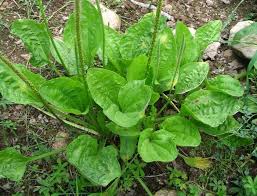 Plantain, Plantago major, goes hand in hand, or tap root in tap root, with our friend the dandelion. It can be identified by its broad, rounded, glossy leaves, with small, greenish flowers. Plantain is most effective when its leaves are administered as a poultice. A plantain poultice works to stop the bleeding of minor cuts, ease pain from bee stings, and prevent swelling. Topically applied, oil infusions of plantain work to quickly heal cuts, bruises, scratches, stings, and rashes.
Plantain, Plantago major, goes hand in hand, or tap root in tap root, with our friend the dandelion. It can be identified by its broad, rounded, glossy leaves, with small, greenish flowers. Plantain is most effective when its leaves are administered as a poultice. A plantain poultice works to stop the bleeding of minor cuts, ease pain from bee stings, and prevent swelling. Topically applied, oil infusions of plantain work to quickly heal cuts, bruises, scratches, stings, and rashes.
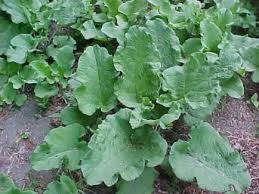 Another delightful, medicinal tap root is burdock, Articum lappa. It can be identified by its large leaves with red stalks, and wooly undersides. When processed into a tincture, burdock root is a supreme liver, kidney, and blood purifier. As a tonic, burdock cleanses the lymph, sweat, and oil glands. When applied topically as a poultice or oil infusion, it can heal heated skin conditions such as acne, rashes, eczema, and burns. Although not the tastiest of root vegetables, when eaten, burdock improves intestinal flora.
Another delightful, medicinal tap root is burdock, Articum lappa. It can be identified by its large leaves with red stalks, and wooly undersides. When processed into a tincture, burdock root is a supreme liver, kidney, and blood purifier. As a tonic, burdock cleanses the lymph, sweat, and oil glands. When applied topically as a poultice or oil infusion, it can heal heated skin conditions such as acne, rashes, eczema, and burns. Although not the tastiest of root vegetables, when eaten, burdock improves intestinal flora.
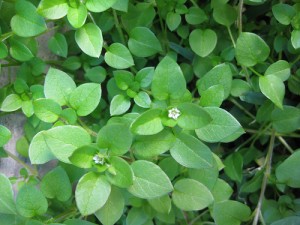 Chickweed, Stellaria media, can be identified by its small, white flowers and low, dense, creeping green foliage with a single line of hairs on its smooth stalks. Chickweed is most commonly eaten as medicine, packed with essential nutrients, such as calcium, potassium, protein, and vitamin C, to name a few. When taken as a tea or tincture, chickweed cools heated chest congestions and eases bladder and kidney discomfort. Applied topically as a poultice or oil infusion, chickweed draws out infection, decreases swelling, and heals minor injuries, itches, bites, sores, bruises, and blisters.
Chickweed, Stellaria media, can be identified by its small, white flowers and low, dense, creeping green foliage with a single line of hairs on its smooth stalks. Chickweed is most commonly eaten as medicine, packed with essential nutrients, such as calcium, potassium, protein, and vitamin C, to name a few. When taken as a tea or tincture, chickweed cools heated chest congestions and eases bladder and kidney discomfort. Applied topically as a poultice or oil infusion, chickweed draws out infection, decreases swelling, and heals minor injuries, itches, bites, sores, bruises, and blisters.
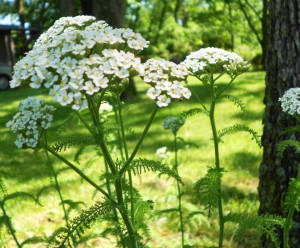 And last but not least, yarrow! Yarrow, Achillea millefolium, can be identified by its feathery, sprawling leaves and flat, composite, white flowers. While there are many beautiful, brightly colored hybrids of yarrow in our gardens, only the wild, native variety found in meadows is medicinal. Yarrow is traditionally used as an antiseptic poultice for wounds, drawing out infection and stopping bleeding internally and externally. Yarrow’s flowers can be taken as a tea to stimulate the immune system at the onset of a cold or flu, control fevers, and promote sweating from colds and flues. In tincture form, yarrow flowers work to boost the immune system and serve as a digestive aid and liver cleanser.
And last but not least, yarrow! Yarrow, Achillea millefolium, can be identified by its feathery, sprawling leaves and flat, composite, white flowers. While there are many beautiful, brightly colored hybrids of yarrow in our gardens, only the wild, native variety found in meadows is medicinal. Yarrow is traditionally used as an antiseptic poultice for wounds, drawing out infection and stopping bleeding internally and externally. Yarrow’s flowers can be taken as a tea to stimulate the immune system at the onset of a cold or flu, control fevers, and promote sweating from colds and flues. In tincture form, yarrow flowers work to boost the immune system and serve as a digestive aid and liver cleanser.
This is just a glimpse at a few of the medicinal qualities of the common weeds found on Nantucket. We have found that these are not weeds at all, but nature’s medicine waiting to be eaten, drunk, or slathered all over our aching, over-worked bodies. So next time you’re hustling through a garden bed, thoughtlessly adding weeds to your compost pile, think again! That dandelion could help your hangover, that burdock could erase your acne, that yarrow could cure your cold.
Herbal product terms:
Oil infusion: The product of infusing oil with plant material to withdraw the medicinal qualities of the plant into the oil, often used with beeswax to make salves, applied topically
Poultice: Crushed up, fresh plant material that is applied to infected area on skin
Tea: The product of dried, crushed plant material infused in hot water for drinking
Tincture: The product of infusing alcohol with plant material to withdraw the medicinal qualities of the plant into the alcohol, commonly taken orally for internal purposes.
– Sally Obremski
